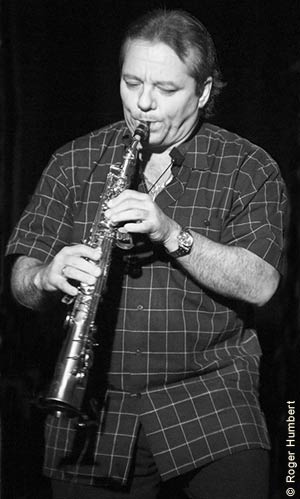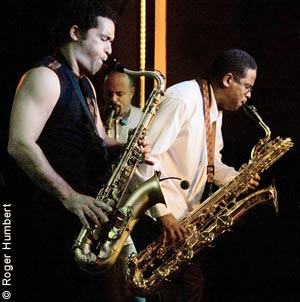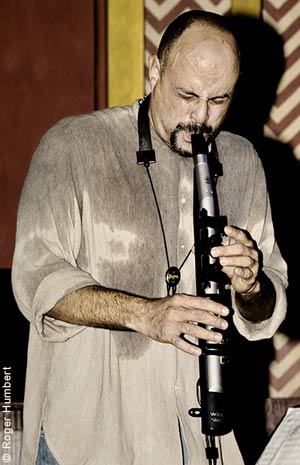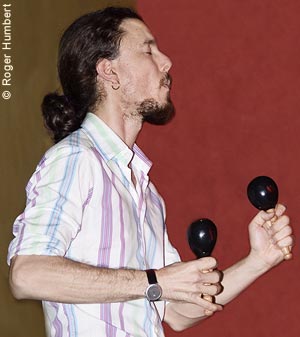|
What type of music do they play? Tangents and tributaries lead away from any attempt at a concise, straight-ahead description. The stuff of books. Here are some prompts — bebop, cubop, African chants, classical, new music, funk, mambo. It might be accurate to say that they are creating Cuban Classical Music, in the way that Dizzy Gillespie and Mingus were creating African-American Classical Music. For sure, an evening with them is a journey through the timescape of music in Cuba.
Angel starts the first piece on EWI. Everyone plays in different directions, while a heavy Latin rhythm fuses them. Dizzy-ing. The four sax registers sound together. Mingus meets Klezmer, organized chaos. Three saxes in a circle, interweaving rhythmic phrases, soprano soloing over it all. Percussion, drums, clave. “Manteca”!
Three more jazz standards are on the menu — “Caravan”, “Yardbird Suite” and “Summertime”. “Yardbird Suite” goes so outside at the end, I wonder, how can this not be orchestrated? These guys are everywhere, yet never clash. Their irreverent version of “Summertime” goes through numerous permutations and peregrinations. In contrast to the heart-tugging melancholy usually at its core, this version moves into salsa territory with Eduardo on tenor and Evaristo on baritone doing the box step while they play. Tongue in cheek, they sing “mi corazon, boom, boom, mi corazon, boom, boom” crossing their hands and hitting their chests. But, at the end, they turn to face the back of the stage, playing sax again, as behind his kit, the drummer stands and sings intricate rhythms with Angel and Jorge. Seconds ago laughing, the room now sits in silent reverence as the “Summertime” melody again takes hold.
“Mambomania”, starts with a short repeated riff and a funky shuffle rhythm. It’s a syncopated serenade of rich saxophone harmonies, countermelodies, and winding soprano lines leading to four voices singing “mambomania”, unison and harmony.
An African jazz piece, with the accent on African, takes the band through a fluid evolution of configurations and changing roles. It makes for a very interesting piece, aurally and visually. As an opener, Angel plays congas and alto simultaneously and Evaristo plays both baritone and percussion. Then the four saxophonists play with what sounds like a percussion section behind them, in reality, 'only' Francois. Three of them become singers playing imaginary drums. All wind instruments laid aside, everyone plays percussion — cowbells, djembes, maracas and drums. Evaristo starts what could be a chant from past centuries as the percussion quiets and the light fades. Only the odd soft percussive accent embellishes his chanting now. And ever so gradually, the haunting sound of his voice evaporates.
Another piece showcases the virtuosity of Jorge Almeida. It starts with Jorge alone on stage, notes tumbling forth from his soprano in a sort of classical-jazz, Bach-unleashed manner and ends with the entire band back on stage in raucous bebop ectasy. The atmosphere for an African piece is set up with the drummer and three of the sax players on a darkened stage, talking as they sit down with tiny identical hand drums. Each playing different parts, they move through complex rhythms, until Evaristo comes on stage and sings a cappella.The four others join in harmony, and fall silent, Evaristo again singing alone. The finale, reached in stages, sees them all singing, clapping rhythms and moving side to side while stamping their feet, using the stage as a bass drum.
One more piece I must mention features drummer Francois playing a maracas solo. What a musical imagination and mastery — a big word when we’re talking about maracas, but such it is — of the instrument he shows. He starts out simple and builds his solo. He shakes the maracas, tight fisted, in front. Seemingly alive, one and sometimes both of them takes his hand out and up — flight of the bumble bee. He reins them in sharply, creating more complex rhythms. He whistles. He shakes one horizontally, sweeping it across in front of his mouth like an electric toothbrush. He hits their wooden stems together sounding the clave, accompanied by maracas. He hums a melody. The rest of the band come back on stage and play punctuated playful jazz.
The piece is somewhat like “Wapango” from their latest CD. It is one of the freshest-sounding pieces I’ve heard in a while with classical allusions and klezmer affinities that make me think of Don Byron’s Bug Music CD. It’s partly the bug sounds the maracas bring to mind, (cicadas for me), and partly a similarity of spirit and sound, particularly with the R.Scott composition, “The Penguin”.
|
|

Jorge Luis Almeida |
|

Eduardo Fernandez & Evaristo Denis |
|

Angel Ballester Veliz |
|

François Zayas Puertas |
|






